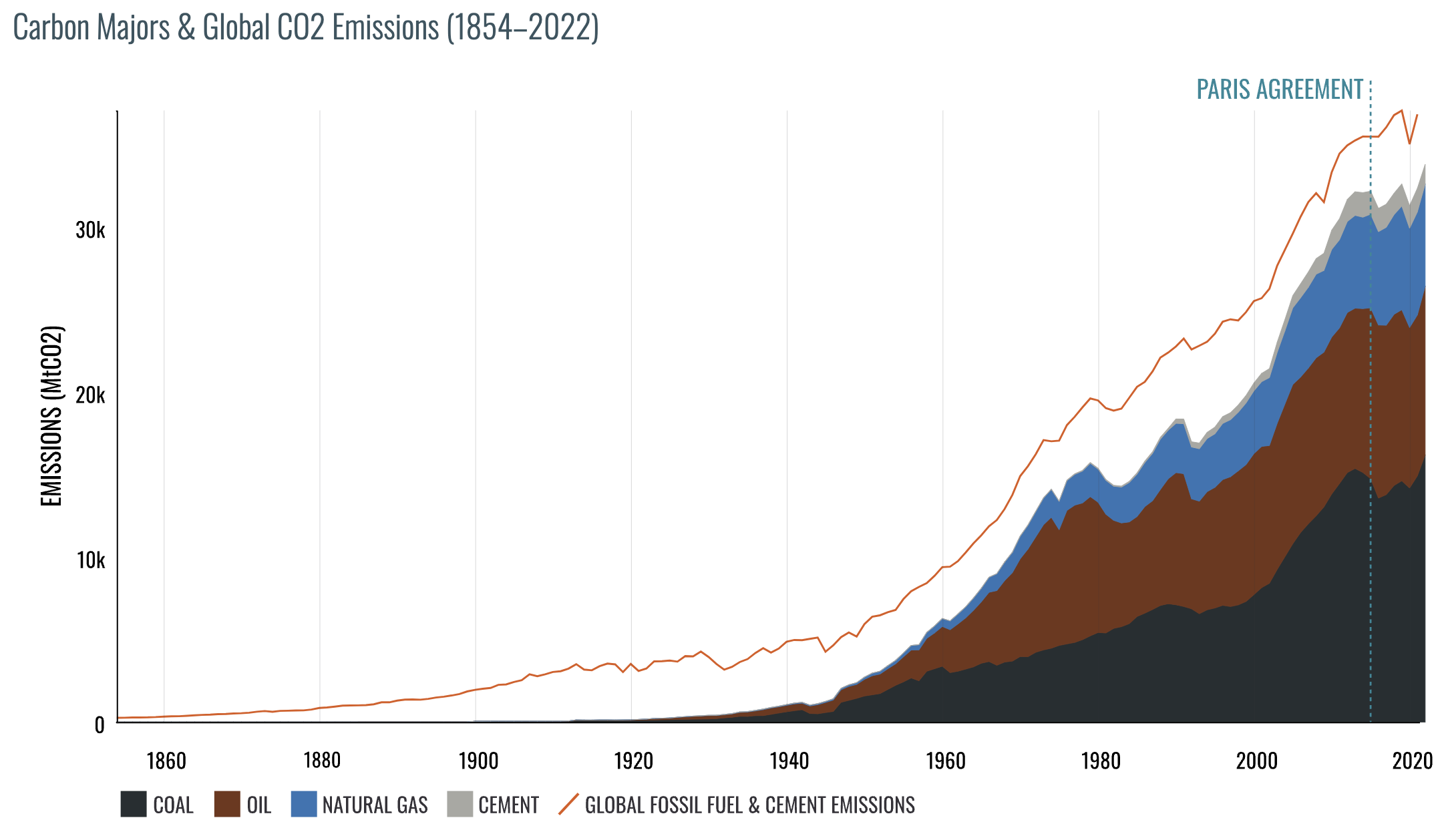According to a Carbon Majors report by non-profit think tank InfluenceMap, the majority of carbon dioxide emissions since 2016 were released by a group of 57 fossil fuel and cement producers, with the vast majority of emissions coming from state owned companies like state-owned oil firm Saudi Aramco, Russia’s state-owned energy company Gazprom and state-owned producer Coal India, which were the three top-emitting carbon dioxide companies since 2016. From 2016 to 2022, the 57 companies produced 80 percent of the world’s carbon dioxide emissions. The report found most countries had expanded their fossil fuel production since 2015, the year when nearly all countries signed the U.N. Paris Agreement. Since then, many of those countries have produced and consumed more fossil fuels, causing carbon dioxide emissions to increase, with global energy-related carbon dioxide emissions hitting a record high last year. According to the report, a relatively small group of emitters were responsible for the bulk of ongoing carbon dioxide emissions.
The report categorizes entities into three types: nation-states accounting for 36 percent (516 GtCO2e) of all emissions tracked by the database, with China’s coal production and the former Soviet Union the largest contributors, state-owned companies accounting for 33 percent (465 GtCO2e), with Saudi Aramco, Gazprom, and the National Iranian Oil Company being the largest contributors, and investor-owned companies accounting for 31 percent (440 GtCO2e), with Chevron, ExxonMobil, and BP the three largest contributors respectively. Between 2016 and 2022, nation-state producers accounted for 38 percent of emissions in the database, state-owned entities account for 37 percent and investor-owned companies for 25 percent, with investor-owned companies dropping their share by 6 percentage points.
Emissions by Entity Type (1940–2022)

The database showed that most state- and investor-owned companies have expanded their production operations since the Paris Agreement. 58 out of the 100 companies were linked to higher emissions in the seven years after the Paris Agreement than in the same period before. The increase was most pronounced in Asia, where 13 out of 15 (87 percent) assessed companies are connected to higher emissions in 2016–2022 than in 2009–2015, and in the Middle East, where it was 7 out of 10 companies (70 percent). In Europe, 13 of 23 companies (57 percent), in South America, 3 of 5 (60 percent) companies, and in Australia, 3 out of 4 (75 percent) companies were linked to increased emissions, as were 3 of 6 (50 percent) African companies. North America is the only region where a minority of companies, 16 of 37 (43 percent), were linked to rising emissions.
The database also showed that there was a shift in coal supply in the seven-year period after the Paris Agreement from investor-owned companies to state-controlled entities. Global coal consumption increased by almost 8 percent from 2015 to 2022, reaching an all-time high of 8.3 billion metric tons. The database shows that from 2015 to 2022, carbon dioxide emissions linked to investor-owned coal production decreased by 28 percent, while carbon dioxide emissions linked to state-owned companies’ and nation-states’ coal production increased by 29 percent and 19 percent, respectively.
The database was first launched in 2013 by the non-profit research organization Climate Accountability Institute, containing historic production data from 122 of the world’s largest oil, gas, coal, and cement producers. It combines companies’ self-reported data on coal, oil and gas production with sources like the U.S. Energy Information Administration, national mining associations and other industry data.
Global Carbon Dioxide Emissions Reach a Record High
Global energy-related emissions of carbon dioxide (CO2) hit a record high in 2023, increasing by 410 million metric tons, or 1.1 percent, to 37.4 billion metric tons. Emissions from coal accounted for more than 65 percent of that increase. While the amount of wind, solar and electric vehicles all increased in 2023, a reopening of China’s economy from its COVID lockdowns, increased fossil fuel use, low hydropower output and a recovery in the aviation sector led to the overall rise. The 2023 increase in carbon dioxide emissions was slightly less than the increase in 2022 when emissions increased by 490 million metric tons (1.3 percent).
Emissions in China increased by 565 million metric tons in 2023, by far the largest increase globally and a continuation of China’s emissions-intensive economic growth in the post-pandemic period. In China, the world’s largest carbon dioxide emitter, per capita emissions are 15 percent higher than in advanced economies. In India, the world’s third largest carbon dioxide emitter, strong GDP growth drove up emissions by 190 million metric tons. Per capita emissions in India remain far below the world average. In comparison, the United States, the world’s second largest carbon dioxide emitter, saw a decrease in energy-related carbon dioxide emissions of 4.1 percent with the bulk of the reduction coming from the electricity sector.
Conclusion
Recent trends show that investor-owned companies are plateauing or decreasing their energy-related carbon dioxide emissions while state- and nation-owned companies are emitting greater and greater emissions. The three largest emitting companies between 2016 and 2022 are in Saudi Arabia, Russia and India—all state owned. China, however, remains the largest emitter of carbon dioxide emissions in 2023. Globally, energy-related carbon dioxide emission increased by 1.1 percent in 2023, with most countries increasing their emissions. The United States, however, saw a 4.1 percent decline in energy-related carbon dioxide emissions in 2023, according to the International Energy Agency.